Loet Leydesdorff (2001)
Technology and Culture:
The
Dissemination and the Potential 'Lock-in' of New Technologies
Journal of Artificial Societies and Social Simulation
vol. 4, no. 3,
To cite articles published in the Journal of Artificial Societies and Social Simulation, please reference the above information and include paragraph numbers if necessary
<https://www.jasss.org/4/3/5.html>
Received: 5-Nov-00
Accepted: 11-Apr-01
Published: 30-Jun-01
 Abstract
Abstract
![]() Introduction
Introduction
10 SCREEN 1: WINDOW (0, 0)-(320, 200): CLS
20 RANDOMIZE TIMER
30 FOR I = 1 TO 500000
40 y = INT(RND * 200)
50 x = INT(RND * 320)
60 IF RND < .5 GOTO 70 ELSE GOTO 80
70 PSET (x, y), 1: GOTO 90
80 PSET (x, y), 2
90 NEXT I
100 END
| Table 1. Program for picturing a screen randomly using two colours | |
| This code may be downloaded from here and run under Windows | |
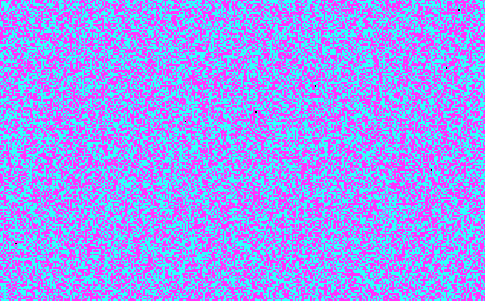
|
| Figure 1. Screen (320 x 200) pictured randomly in two colours |
1 REM network model with Von Neumann environment
2 REM and spatial representation on the screen
10 SCREEN 1: WINDOW (0, 0)-(320, 200): CLS
20 RANDOMIZE TIMER
30 ' $DYNAMIC
40 DIM scrn(321, 201) AS INTEGER
50 FOR I = 1 TO 500000
60 y = INT(RND * 200)
70 x = INT(RND * 320)
80 IF (x = 0 OR y = 0) GOTO 120
‘ prevention of errors at the margins
90 z = scrn(x - 1, y) + scrn(x + 1, y) + scrn(x, y - 1) + scrn(x, y + 1)
100 IF z = 0 GOTO 120
‘ use random attribution in this case
110 IF z > 0 THEN GOTO 130 ELSE GOTO 140
‘ evaluation of neighbours if z <> 0
120 IF RND < .5 THEN GOTO 130 ELSE GOTO 140
130 PSET (x, y), 1: scrn(x, y) = 1: GOTO 150
140 PSET (x, y), 2: scrn(x, y) = -1
150 NEXT I
160 END
| Table 2. Program for network effect of a ‘Von Neumann environment’ using two colours | |
| This code may be downloaded from here and run under Windows | |
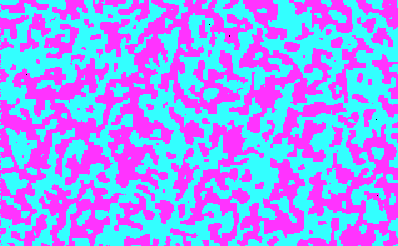
|
| Figure 2. The network effect in the case of a 'Von Neumann environment' using two colours |
91 z = z + scrn(x-1,y-1) + scrn(x-1,y+1) + scrn(x+1,y-1) + scrn(x+1,y+1)

|
| Table 3. Returns to adopting A or B, given nA and nB previous adopters of A and B. (The model assumes that aR > bR and that bS > aS. Both r and s are positive.) |
1 REM original model of W. Brian Arthur (1988)
2 REM with spatial representation on the screen
20 SCREEN 1: WINDOW (0, 0)-(320, 200): CLS
30 ar = .8: br = .2: sa = .2: bs = .8: na = 1: nb = 1: s = .01: r = .01
40 RANDOMIZE TIMER
50 FOR I = 1 TO 500000
60 y = INT(RND * 200)
70 x = INT(RND * 320)
80 IF RND < .5 GOTO 90 ELSE GOTO 120
90 returna = ar + r * na: returnb = br + r * nb
100 IF returna > returnb THEN na = na + 1 ELSE nb = nb + 1
110 IF returna > returnb GOTO 150 ELSE GOTO 160
120 returna = sa + s * na: returnb = bs + s * nb
130 IF returna > returnb THEN na = na + 1 ELSE nb = nb + 1
140 IF returna > returnb GOTO 150 ELSE GOTO 160
150 PSET (x, y), 1: GOTO 170
160 PSET (x, y), 2
170 NEXT I
180 END
| Table 4. Code for the simulation of Arthur's (1988) model (cf. Leydesdorff & Van den Besselaar, 1998) | |
| This code may be downloaded from here and run under Windows | |
1 REM original model of W. Brian Arthur (1988)
2 REM with network effect of the Von Neumann environment
3 REM added in lines 100-130
20 SCREEN 1: WINDOW (0, 0)-(320, 200): CLS
30 ar = .8: br = .2: sa = .2: bs = .8: na = 1: nb = 1: s = .01: r = .01
40 ' $DYNAMIC
50 DIM scrn(321, 201) AS INTEGER
60 RANDOMIZE TIMER
70 FOR I = 1 TO 500000
80 y = INT(RND * 200)
90 x = INT(RND * 320)
95 REM first evaluate the network environment (Table 2)
100 IF (x = 0 OR y = 0) GOTO 140
110 z = scrn(x – 1, y) + scrn(x + 1, y) + scrn(x, y - 1) + scrn(x, y + 1)
120 IF z = 0 GOTO 140
130 IF z > 0 THEN GOTO 210 ELSE GOTO 220
135 REM if not decisive proceed with the lock-in model (Table 4)
140 IF RND < .5 GOTO 150 ELSE GOTO 180
150 returna = ar + r * na: returnb = br + r * nb
160 IF returna > returnb THEN na = na + 1 ELSE nb = nb + 1
170 IF returna > returnb GOTO 210 ELSE GOTO 220
180 returna = sa + s * na: returnb = bs + s * nb
190 IF returna > returnb THEN na = na + 1 ELSE nb = nb + 1
200 IF returna > returnb GOTO 210 ELSE GOTO 220
210 PSET (x, y), 1: scrn(x, y) = 1: GOTO 230
220 PSET (x, y), 2: scrn(x, y) = -1
230 NEXT I
240 END
| Table 5. Code for the combination of a local network effect with the global lock-in effect | |
| This code may be downloaded from here and run under Windows | |
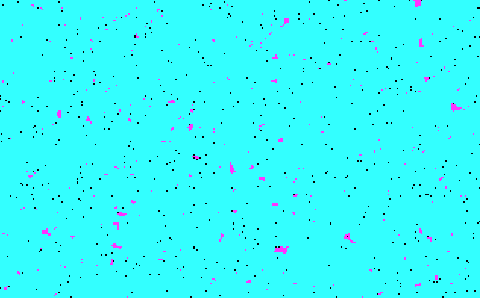
|
| Figure 3.Temporary network effects with a prevailing lock-in after appr. 250,000 adopters |
1 REM network model with Von Neumann environment
2 REM and spatial representation on the screen
3 REM ‘learning’ added (to Table 2) by extension of lines 130 and 140
10 SCREEN 1: WINDOW (0, 0)-(320, 200): CLS
20 RANDOMIZE TIMER
30 ' $DYNAMIC
40 DIM scrn(321, 201) AS INTEGER
50 FOR I = 1 TO 500000
60 y = INT(RND * 200)
70 x = INT(RND * 320)
80 IF (x = 0 OR y = 0) GOTO 120
‘provision in order to prevent effects at the margins
90 z = scrn(x - 1, y) + scrn(x + 1, y) + scrn(x, y - 1) + scrn(x, y + 1)
100 IF z = 0 GOTO 120
110 IF z > 0 THEN GOTO 130 ELSE GOTO 140
120 IF RND < .5 THEN GOTO 130 ELSE GOTO 140
‘specification of the learning effect
130 PSET (x, y), 1: scrn(x, y) = scrn (x, y) + 1: GOTO 150
140 PSET (x, y), 2: scrn(x, y) = scrn (x, y) – 1
150 NEXT I
160 END
| Table 6. Code for the extension of a network effect with local learning | |
| This code may be downloaded from here and run under Windows | |
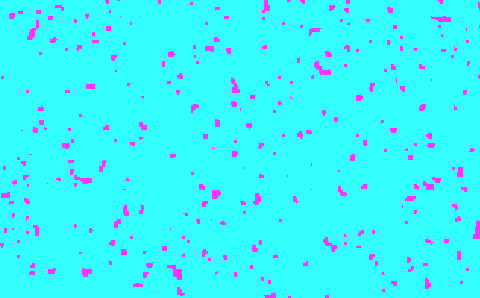
|
| Figure 4. Stable network effects based upon learning with prevailing lock-in after 500,000 adopters |
Culture is taken to be what social influence influences. For present purposes, the emphasis is not on the content of a specific culture, but rather on the way in which any culture is likely to emerge and spread. Thus, the model assumes that an individual's culture can be described in terms of his or her attributes, such as language, religion, technology, style of dress, and so forth.
1 REM Axelrod's ‘Disseminating Culture’ (1997, pp. 154 ff.)
2 REM five features, ten traits
10 SCREEN 7: WINDOW (0, 0)-(320, 200): CLS
20 ' $DYNAMIC
'technical limitation of
30 DIM scrn(221, 101, 5) AS INTEGER
'array size in QBasic 4.5
40 RANDOMIZE TIMER
50 FOR z = 0 TO 4
'five features
60 FOR y = 0 TO 99
'fill array and paste screens
70 FOR x = 0 TO 219
90 w = INT(10 * RND)
'ten random traits
100 IF z = 4 THEN PSET (x, y), (w + 6): scrn(x, y, z) = w
'use colours 6 to 15 (see note 7); show fifth screen
110 NEXT x
120 NEXT y
130 NEXT z
140 DO
'continue to exhibit the screen for z = 4
150 y = INT(RND * 100)
'select a random array element
160 x = INT(RND * 220)
170 zz = INT(RND * 4)
'attribute relevant neighbourhood elements randomly
180 IF zz = 0 THEN x2 = x - 1: y2 = y
190 IF zz = 1 THEN x2 = x + 1: y2 = y
200 IF zz = 2 THEN x2 = x: y2 = y - 1
210 IF zz = 3 THEN x2 = x: y2 = y + 1
'repair effects at the margins
220 IF x2 = -1 THEN x2 = 219: IF x2 = 220 THEN x2 = 0
230 IF y2 = -1 THEN y2 = 99: IF y2 = 100 THEN y2 = 0
240 c = 0
'compute relative similarity with selected neighbour
250 FOR z = 0 TO 4
260 IF scrn(x2, y2, z) = scrn(x, y, z) THEN c = c + 1
270 NEXT z
280 p = .2 * c
'degree of similarity
290 IF RND > p THEN GOTO 360
'only interact with probability p; otherwise loop
300 noneq = INT((5 - c) * RND)
'adjust a randomly chosen trait
310 FOR z = 0 TO 4
'in the case of dissimilarity using five features
320 IF scrn(x2,y2,z) <> scrn(x,y,z) THEN GOTO 330 ELSE noneq = (noneq+1)
330 IF noneq = z THEN scrn(x,y,z) = scrn(x2,y2,z)
'adjust colour, that is, trait, in this case only
340 NEXT z
350 PSET (x, y), (scrn(x, y, 4) + 6)
'repaint the screen
360 LOOP WHILE INKEY$ = ‘‘
'make it possible to exit
370 END
| Table 7. A reconstruction of Axelrod's (1997) 'Disseminating Culture' | |
| This code may be downloaded from here and run under Windows | |
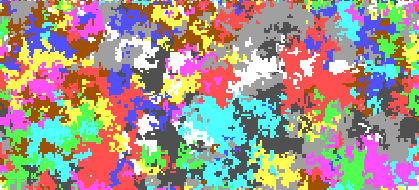
|
| Figure 5. Small worlds simulation based on Axelrod's (1997) 'Disseminating Culture' (after a few hours of simulation) |
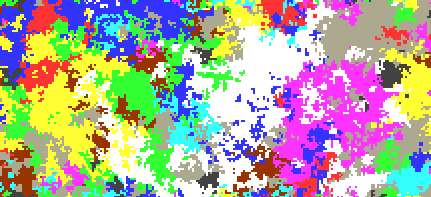
|
| Figure 6. Small worlds simulation based on Axelrod's (1997) 'Disseminating Culture' (after 72 hours) |
The Addition of an Emerging (sixth) Dimension
1 REM five features, ten traits, sixth feature emerging
10 SCREEN 7: WINDOW (0, 0)-(320, 200): CLS
20 ' $DYNAMIC
'technical limitation of
30 DIM scrn(221, 101, 6) AS INTEGER
'array size in QBasic 4.5
40 RANDOMIZE TIMER
50 FOR z = 0 TO 5
'five initial features
60 FOR y = 0 TO 99
'fill arrays and paste screens
70 FOR x = 0 TO 219
90 w = INT(10 * RND)
100 IF z = 5 THEN scrn(x,y,z) = -1 ELSE scrn(x, y, z) = w
101 IF z = 4 THEN PSET(x, y), (w+ 6)
'show fifth screen
110 NEXT x
120 NEXT y
130 NEXT z
140 DO
150 y = INT(RND * 100)
160 x = INT(RND * 220)
161 IF scrn(x, y, 5) = -1 THEN helpvar1 = 4 ELSE helpvar1 = 5
170 zz = INT(RND * 4)
'attribute relevant neighbourhood elements randomly
180 IF zz = 0 THEN x2 = x - 1: y2 = y
190 IF zz = 1 THEN x2 = x + 1: y2 = y
200 IF zz = 2 THEN x2 = x: y2 = y - 1
210 IF zz = 3 THEN x2 = x: y2 = y + 1
'repair effect at the margins
220 IF x2 = -1 THEN x2 = 219: IF x2 = 220 THEN x2 = 0
230 IF y2 = -1 THEN y2 = 99: IF y2 = 100 THEN y2 = 0
240 c = 0
'compute relative similarity with relevant neighbour
250 FOR z = 0 TO helpvar1
260 IF scrn(x2, y2, z) = scrn(x, y, z) THEN c = c + 1
270 NEXT z
280 IF helpvar1 = 4 THEN p = .2 * c ELSE p = .1666 * c
290 IF RND > p THEN GOTO 360
'only interact with probability p
300 IF helpvar1 = 4 THEN noneq = INT((5 - c) * RND) ELSE noneq = INT((6 - c) * RND)
310 FOR z = 0 TO helpsvar1
'in the case of dissimilarity
320 IF scrn(x2, y2, z) <> scrn(x, y, z) THEN GOTO 330 ELSE noneq = (noneq + 1)
330 IF noneq = z THEN scrn(x, y, z) = scrn(x2, y2, z)
'adjust colour
331 IF (noneq = z and scrn(x,y,5) < 9) THEN SCRN(X, Y, 5) = scrn(x, y, 5) + 1
'emerging dimension
340 NEXT z
350 PSET (x, y), (scrn(x, y, 4) + 6)
'repaint the screen
351 IF scrn(x, y, 5) > -1 THEN PSET (x, y + 100), (scrn(x, y, 5) + 6)
360 LOOP WHILE INKEY$ = ‘‘
'make it possible to exit
370 END
| Table 8. Emergence of a sixth feature feeding into the culture; changes in relation to the previous simulation model are in boldface | |
| This code may be downloaded from here and run under Windows | |
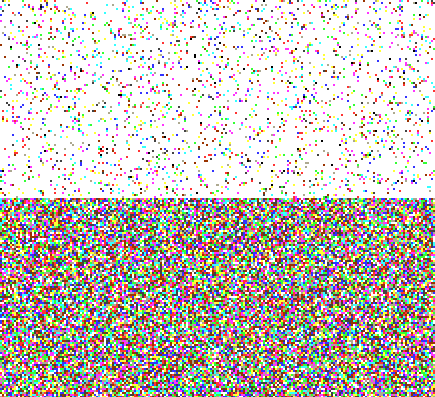
|
| Figure 7. Emergence of a sixth dimension (steady state situation after a number of hours); no regionalization occurring. |
1 REM five features, ten traits, sixth feature emerging
10 SCREEN 7: WINDOW (0, 0)-(320, 200): CLS
20 ' $DYNAMIC
'technical limitation of
30 DIM scrn(221, 101, 6) AS INTEGER
'array size in QBasic 4.5
40 RANDOMIZE TIMER
41 ar = .8: br = .2: sa = .2: bs = .8: na = 1: nb = 1: s = .01: r = .01
'additional declaration for Arthur routine (see Table 2)
50 FOR z = 0 TO 5
'five initial features
60 FOR y = 0 TO 99
'fill arrays and paste screens
70 FOR x = 0 TO 219
90 w = INT(10 * RND)
100 IF z = 5 THEN scrn(x,y,z) = -1 ELSE scrn(x, y, z) = w
101 IF z = 4 THEN PSET(x, y), (w+ 6)
110 NEXT x
120 NEXT y
130 NEXT z
140 DO
150 y = INT(RND * 100)
160 x = INT(RND * 220)
161 IF scrn(x, y, 5) = -1 THEN helpvar1 = 4 ELSE helpvar1 = 5
170 zz = INT(RND * 4)
'attribute relevant neighbourhood elements randomly
180 IF zz = 0 THEN x2 = x - 1: y2 = y
190 IF zz = 1 THEN x2 = x + 1: y2 = y
200 IF zz = 2 THEN x2 = x: y2 = y - 1
210 IF zz = 3 THEN x2 = x: y2 = y + 1
'attribute relevant neighbours randomly
br>
'repair effect at the margins
220 IF x2 = -1 THEN x2 = 219: IF x2 = 220 THEN x2 = 0
230 IF y2 = -1 THEN y2 = 99: IF y2 = 100 THEN y2 = 0
240 c = 0
'compute relative similarity with relevant neighbour
250 FOR z = 0 TO helpvar1
260 IF scrn(x2, y2, z) = scrn(x, y, z) THEN c = c + 1
270 NEXT z
280 IF helpvar1 = 4 THEN p = .2 * c ELSE p = .1666 * c
290 IF RND > p THEN GOTO 360
'only interact with probability p;
'otherwise use routine for ‘lock-in’ (Table 2)
300 IF helpvar1 = 4 THEN noneq = INT((5 - c) * RND) ELSE noneq = INT((6 - c) * RND)
310 FOR z = 0 TO helpsvar1
'in the case of dissimilarity
320 IF scrn(x2, y2, z) <> scrn(x, y, z) THEN GOTO 330 ELSE noneq = (noneq + 1)
330 IF noneq = z THEN scrn(x, y, z) = scrn(x2, y2, z)
'adjust colour
331 IF (noneq = z and scrn(x,y,5) < 1) THEN SCRN(X, Y, 5) = scrn(x, y, 5) + 1
'two values only !
340 NEXT z
350 PSET (x, y), (scrn(x, y, 4) + 6)
'repaint the screen
351 IF scrn(x, y, 5) > -1 THEN PSET (x, y + 100), (scrn(x, y, 5) + 6)
352 goto 460
'loop
360 IF RND < .5 GOTO 370 ELSE GOTO 400
370 returna = ar + r * na: returnb = br + r * nb
380 IF returna > returnb THEN na = na + 1 ELSE nb = nb + 1
390 IF returna > returnb GOTO 430 ELSE GOTO 440
400 returna = sa + s * na: returnb = bs + s * nb
410 IF returna > returnb THEN na = na + 1 ELSE nb = nb + 1
420 IF returna > returnb GOTO 430 ELSE GOTO 440
430 PSET (x, y), 6: scrn(x, y,5) = 0: GOTO 460
440 PSET (x, y), 7: scrn(x, y,5) = 1
460 LOOP WHILE INKEY$ = ‘‘
'make it possible to exit
470 END
| Table 9. Emergence of a technology feeding into the culture, with the potential of ‘lock-in’ | |
| This code may be downloaded from here and run under Windows | |
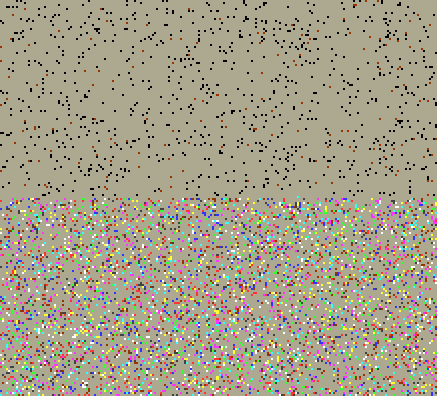
|
| Figure 8. Simulation of the dissemination of culture under the condition of 'lock-in' |
 Notes
Notes2'Selection environments' of 'technological trajectories' (Nelson & Winter, 1982) cannot be considered as 'naturally given.' For example, selection environments may contain 'market' or 'non-market' elements and to varying degrees. The empirical referents of these concepts have to be specified on the basis of theorizing.
3The model described here is equivalent to the cellular automata majority rule and the behaviour is exactly what one would expect from such a cellular automaton (Gilbert & Troitzsch, 1999, at pp. 130 ff.; cf. Toffoli & Margolus, 1987).
4I used the Von Neumann neighbourhood for reasons of parsimony. The Von Neumann neighbourhood is simpler than the Moore neighbourhood, whereas the effects of the two neighbourhoods were rather similar in the case elaborated above.
5However, all species of chaotic behaviour (including crises) can be contained in a model of three interacting subdynamics (Leydesdorff, 2000).
6This size is convenient because of system's limitation (in QBasic 4.5), and because it will allow us in a next simulation to picture two representations above each other on the same screen. In other (commercial) variants of Basic (e.g., PowerBasic) it is possible to circumvene the system's limitation and thus to simulate these models using full screens.
7The colours 6 to 15 of the BASIC palette are used because they are brighter than the colours associated with lower sequence numbers.
8See for this code at <http://pscs.physics.lsa.umich.edu/Software/CC/CC7/CULTURE.P.html>
ARTHUR, W.B., ERMOLIEV, Y.M., KANIOVSKI, Y.M. (1987). 'Path dependent processes and the emergence of a macrostructure,' European Journal of Operational Research, 30: 294-303.
ARTHUR, W. Brian (1988). 'Competing technologies.' In: Dosi, G., Freeman, C., Nelson, R., Silverberg, G., and Soete, L. (Eds.), Technical Change and Economic Theory, London: Pinter, pp. 590-607.
ARTHUR, W. Brian (1989). 'Competing Technologies, Increasing Returns, and Lock-In by Historical Events,' Economic Journal, 99: 116-31.
ARTHUR, W. Brian (1994). Increasing Returns and Path Dependence in the Economy. Ann Arbor: University of Michigan Press.
ARTHUR, W. Brian, DURLAUF, Steven N., LANE, David A. (1997). The Economy as an Evolving Complex System II : Proceedings Santa Fe Institute Studies in the Sciences of Complexity, Vol. 27. Redwood, CA: Addison-Wesley.
AXELROD, Robert (1997a). The Complexity of Cooperation: agent-based models of competition and collaboration. Princeton: Princeton University Press.
AXELROD, Robert (1997b). 'The Dissemination of Culture: A Model with Local Convergence and Global Polarization,' Journal of Conflict Resolution, 41:203-26.
BRUCKNER, Eberhard, EBELING, Werner, JIMENEZ, Miguel A. , Montaño and SCHARNHORST, Andrea (1994). 'Hyperselection and Innovation Described by a Stochastic Model of Technological Evolution.' In: Leydesdorff, L., and Van den Besselaar, P. (Eds.), Evolutionary Economics and Chaos Theory: New directions in technology studies, London and New York: Pinter, pp. 79-90.
DARWIN, Charles (1856). The Origin of Species. London. [The Origin of Species by means of natural selection, or The preservation of favoured races in the struggle for life. 6th ed., London: Murray, 1876.]
DAVID, Paul A. (1985). 'Clio and the Economics of QWERTY,' American Economic Review, 75: 332-7.
ETZKOWITZ, Henry, and LEYDESDORFF, Loet (Eds.) (1997). Universities and the Global Knowledge Economy: A Triple Helix of University-Industry-Government Relations. London: Cassell Academic.
ETZKOWITZ, Henry, and LEYDESDORFF, Loet (2000). 'The Dynamics of Innovation: From National Systems and 'Mode 2' to a Triple Helix of University-Industry-Government Relations,' Research Policy, 29(2): 109-123.
FISHER, J. C., and R. H. Pry (1971). 'A Simple Substitution Model of Technological Change,' Technological Forecasting and Social Change, 3, 75- 88.
FRENKEN, Koen, and LEYDESDORFF, Loet (2000). 'Scaling Trajectories in Civil Aircraft (1913-1997),' Research Policy, 29(3): 331-348.
GIDDENS, Anthony (1984). The Constitution of Society. Cambridge: Polity Press.
GILBERT, Nigel G., and TROITZSCH, Klaus G. (1999). Simulation for the Social Scientist. Buckingham/Philadelphia: Open University Press.
KAUFFMAN, Stuart A. (1993). The Origins of Order: Self-Organization and Selection in Evolution. New York: Oxford University Press.
LANGTON, Christopher G. (Ed.), (1989). Artificial Life. Redwood City, CA: Addison Wesley.
LEYDESDORFF, Loet (1995). The Challenge of Scientometrics: The development, measurement and self-organization of scientific communications. Leiden: DSWO Press, Leiden University; at <http://www.upublish.com/books/leydesdorff-sci.htm>
LEYDESDORFF, Loet (2000). 'The Triple Helix as an Evolutionary Model of Innovations,' Research Policy 29 (2):243-255.
LEYDESDORFF, Loet (2001). A Sociological Theory of Communication: The Self- Organization of the Knowledge-Based Society. Parkland, FL: Universal Publishers, 2001; at <http://www.upublish.com/books/leydesdorff.htm>
LEYDESDORFF, Loet, and VAN DEN BESSELAAR, Peter (1998). 'Competing Technologies: Lock-ins and Lock-outs.' In: Dubois, Daniel M. (Ed.), Computing Anticipatory Systems, Proceedings of the American Institute of Physics 437. Woodbury, NY: American Institute of Physics, pp. 309-23.
LEYDESDORFF, Loet, and ETZKOWITZ, Henry (1998). 'The Triple Helix as a model for innovation studies,' Science and Public Policy. 25(3):195-203.
NELSON, Richard R., and WINTER, Sidney G. (1982). An Evolutionary Theory of Economic Change. Cambridge, MA: Belknap Press.
PEARL, Judea (1988). Probabilistic Reasoning and Artificial Intelligence: Networks of Plausible Inference. San Mateo, CA: Morgan Kaufmann.
PLOURABOUE, Franck, STEYER, Alexandre and ZIMMERMAN, Jean-Benoît (1998). 'Learning Induced Criticality in Consumers' Adoption Patterns: A Neural Network Approach,' Econ. Innov. New Techn., 6:73-90.
SAHAL, Devendra (1982). 'Alternative conceptions of technology,' Research Policy 10:2- 24.
SCHUMPETER, Joseph ([1939] 1964) Business Cycles: A Theoretical, Historical and Statistical Analysis of Capitalist Process. New York: McGraw-Hill.
TOFFOLI, Tommasso, and MARGOLUS, Norman (1987). Cellular Automata Machines. Cambridge, MA: MIT Press.
VAN ALSTYNE, Marshall, and BRYNJLOFSSON, Erik (1996). 'Could the Internet Balkanize Science?' Science 247 (29 November): 1479-1480.
WATTS, Duncan J. (1999). Small Worlds: The Dynamics of Networks between Order and Randomness. Princeton: Princeton University Press.
WATTS, Duncan J. and STROGATZ, Steven H. (1998). 'Collective dynamics of 'small-world' networks,' Nature 393 (4 June): 440-442.
Return to
Contents
of this issue
© Copyright Journal of Artificial Societies and Social Simulation, 2001